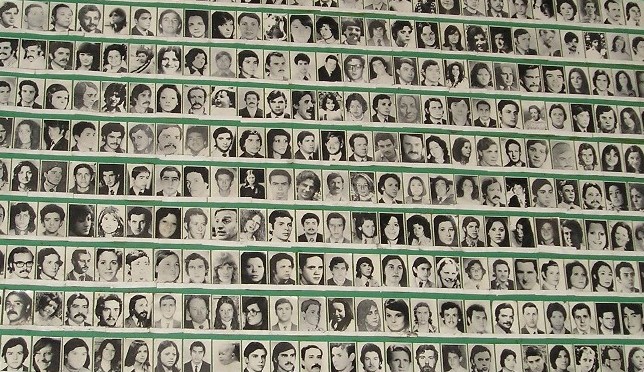LatinaLista — As a developed nation, U.S. citizens are spared most of the atrocities people endure in countries being ravaged by civil war, unrestrained criminal violence and outright ethnic attacks. A popular tool of these types of conflicts is making people disappear, only to either be later found murdered or never found at all.
The families left behind are devastated and left with questions that last a lifetime.
In the Americas, almost every country in Central and South America has experienced a wave of their citizens who have disappeared.
In 2010, the United Nations became alarmed at the “increase in enforced or involuntary disappearances in various regions of the world, including arrest, detention and abduction, when these are part of or amount to enforced disappearances, and by the growing number of reports concerning harassment, ill-treatment and intimidation of witnesses of disappearances or relatives of persons who have disappeared.”
Because of this rising disregard to the human rights of those abducted, the United Nations adopted the International Convention for the Protection of All Persons from Enforced Disappearance and designated August 30 as the date for its international observance.
While in the United States, the observance may not grab headlines, in countries like Guatemala the day reinforces a vigil held by too many families affected by Guatemala’s bloody civil war.
In Guatemala:
According to a 1999 UN-backed truth commission, a total of 6,159 enforced disappearances were registered during Guatemala’s civil war, but many of those who were taken never made it onto the official records. It is estimated that the total number of disappeared people is closer to 45,000.
In Colombia: The number of the disappeared rivals that of Guatemala. In 2008, it was reported that “Every 36 hours on average, someone is forcibly disappeared in Colombia.”
In February, 2013, an article in Colombia Reports stated: In total, the coroner’s office registered that more than 60,000 Colombians have disappeared over the past decades. The U.N. has said the real number of disappeared is most likely to be higher and some human rights organizations claim the total number of people who have disappeared since the start of Colombia’s conflict is close to 250,000.
The tactic of ‘forced disappearances’ of people was so prevalent throughout the Americas that in many of the countries are organizations to help families discover what happened to their loved ones.
In Chile, Los Desaperecidos: During the Pinochet regime, thousands of people were “disappeared” by the security forces. Their families and friends continue to look for them and for answers as to what happened to them and why.
In Argentina: Argentine Forensic Anthropology Team: Human rights organizations estimate the Argentine military dictatorship of the 1970s kidnapped and murdered about 30,000 people. Many of these people were parents, or about to become parents, when they disappeared.
Their parents, especially the mothers, have not stopped looking for their missing children. The most well-known of the groups actively searching for Argentina’s missing is the Mothers of la Plaza de Mayo.
In Honduras: The committee of relatives of the disappeared in Honduras was established in 1982 to keep the memory alive of 69 families who were victims of enforced disappearance.
In Paraguay: A special online museum known as MEVES chronicles the tyranny of General Alfredo Stroessner who orchestrated a coup (golpe) in 1954 that brought him to power in Paraguay. He ruled for the next 35 years, renewing a 90-day “state of siege” every three months (although he’d lift it for one day–election day–so that he could be re-elected president every five years) until the late 80s.
Under his tyranny, millions in Paraguay were victims of what has become known as “Stronismo.”
In Peru: From 1980 to 2000, violent internal conflict wracked Peru, leaving behind an estimated 69,280 dead or disappeared.
Among those are the sons and husbands of the Quechua women. They are members of the National Association of Families of the Kidnapped, Detained and Disappeared of Peru (ANFASEP). In the video below, some of the women describe what happened the last times they saw their loved ones who disappeared during the years of the Shining Path. 15,000 of them have never been found, and the women make their case for the need of a sanctuary of memory in the site where hundreds of them were tortured, murdered and cremated.
In Mexico: In June, Amnesty International declared the number of unsolved disappearances in Mexico as constituting a national scandal and a human rights crisis. They cited what it “called a systematic failure by police and prosecutors to investigate thousands of cases that have piled up since 2006.”
Because of the ongoing cartel violence in the country, many people have disappeared in recent years. In response to these modern-day disappearances, several organizations have tried to help illustrate how widespread is the problem. One example is the crowdmapping of Mexico‘s disappeared.
Other organizations have set up Facebook pages — Fuerzas Unidas por Nuestros Desaparecidos en México and in those parts of Mexico especially hit hard by forced disappearances, organizations have been set up with a more regionalized focus — Fuerzas Unidas por Nuestros Desaparecidos en Coahuila
Almost every South American country has a point in their history where its people have been disposed of because of a difference of opinion or political party.
However, to think that these atrocities don’t affect the United States would be a mistake. Because some of the families who have lost loved ones in this manner and didn’t feel safe in those countries anymore, fled to the United States.
They may have left behind the tyranny and abuse but they will always carry the memories of what their families endured under a government who put the people last.
Featured Photo: Entitled “Que digan dondé están,” comes out of the most violent period of dictatorship Argentina ever saw. Source: Histories of Dreams and Catastrophe blog)



